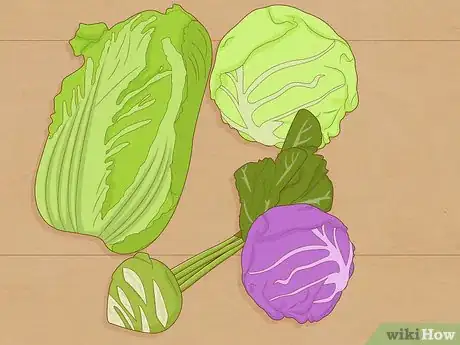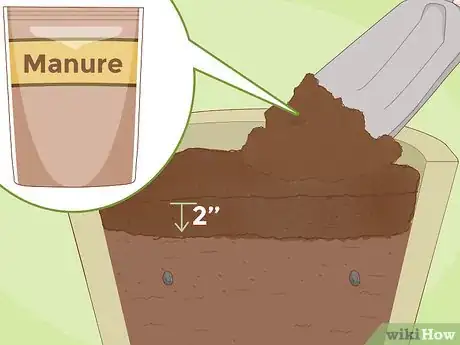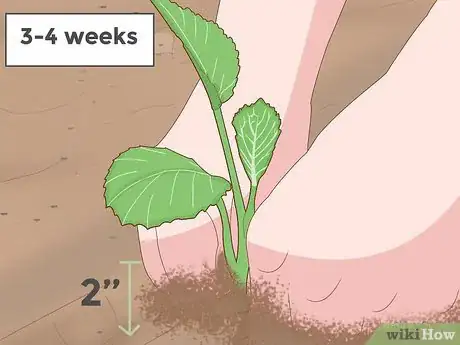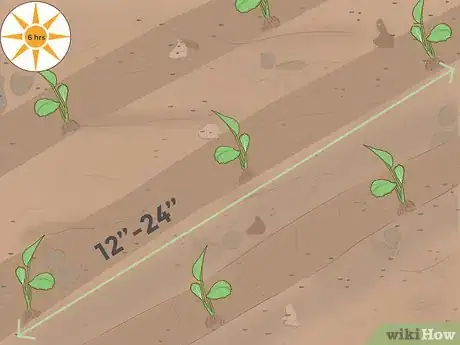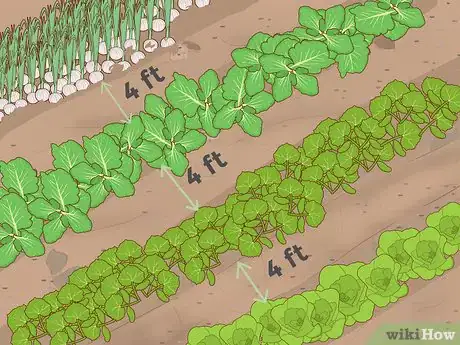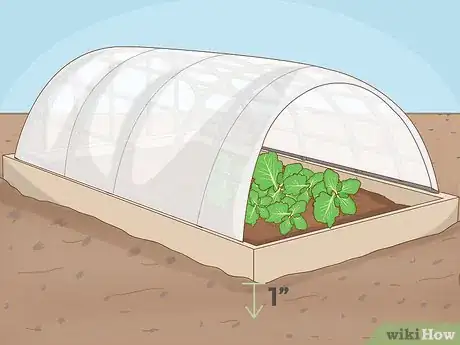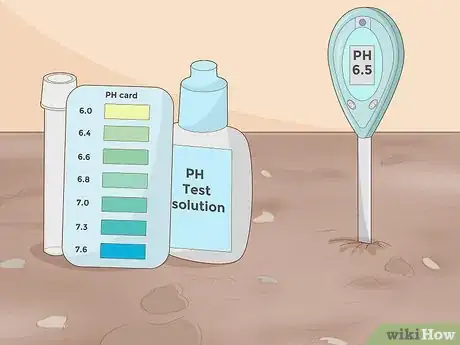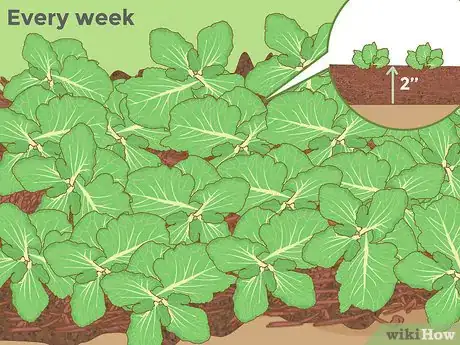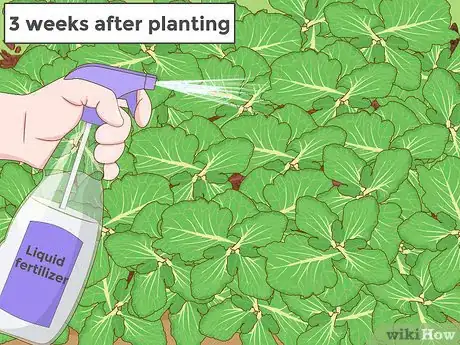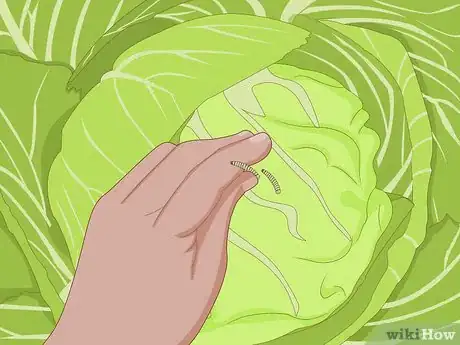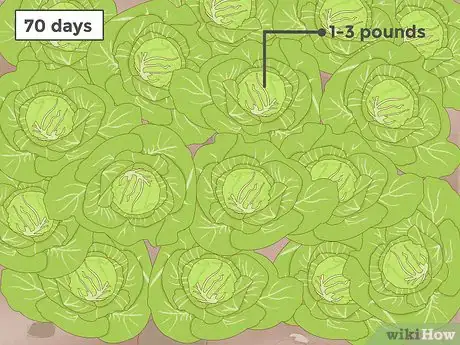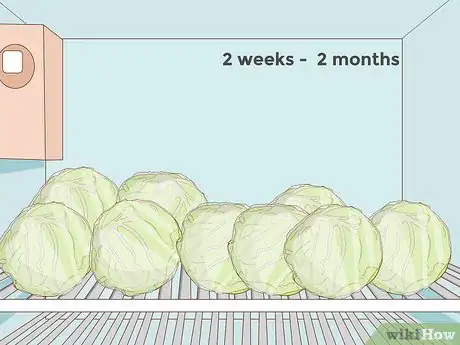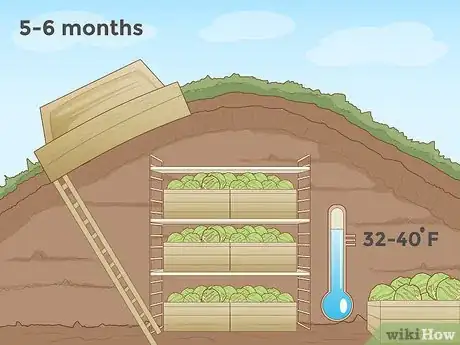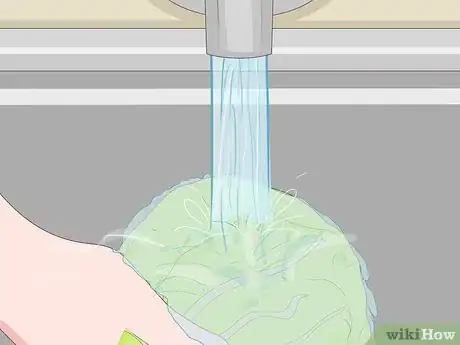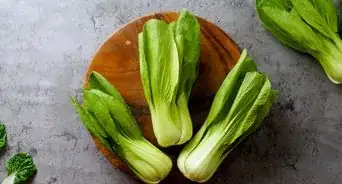This article was co-authored by Lauren Kurtz and by wikiHow staff writer, Jennifer Mueller, JD. Lauren Kurtz is a Naturalist and Horticultural Specialist. Lauren has worked for Aurora, Colorado managing the Water-Wise Garden at Aurora Municipal Center for the Water Conservation Department. She earned a BA in Environmental and Sustainability Studies from Western Michigan University in 2014.
There are 7 references cited in this article, which can be found at the bottom of the page.
This article has been viewed 20,081 times.
Cabbage is a hearty staple with a variety of culinary uses. With careful planning, you can grow a supply of cabbage that will last you all year. While the plant is relatively hardy, it requires regular fertilizer and plenty of sun to grow well. Start your cabbages in early spring and tend to them at least a couple of times a week to keep them clean and healthy.[1]
Steps
Planting Your Cabbage
-
1Choose multiple varieties of cabbage. You'll have a longer harvest if you plant several varieties that have different maturities. If your cabbages are maturing at different times, you'll have fresh cabbage longer. Cabbage maturities vary from 60 to 120 days.[2]
- Cabbage varieties are grouped according to when they are harvested. Spring cabbages are ready the earliest, from mid to late spring. Summer cabbages can be harvested in late summer and early fall. Cabbages categorized as fall and winter cabbages are harvested later in the fall.
- If you want a variety with a longer harvesting period, you might pick the Savoy cabbage. The harvesting season for this variety starts in early fall and extends into winter and early spring of the next year.
-
2Start seeds 6 to 8 weeks before the last spring frost. Sow your seeds .25 inches (0.64 cm) deep and 2 inches (5.1 cm) apart. Place them in a spot where they'll get plenty of sunlight, or set them under grow lamps with temperatures between 60 and 70 °F (16 and 21 °C).[3]
- If you don't want to start your cabbage from seeds yourself, you can buy transplant seedlings from a local grower or at a nursery or farmer's market.
Advertisement -
3Prepare soil with aged manure or fertilizer and compost. Till the soil of your planting bed to a depth of about 2 inches (5.1 cm) and mix in a layer of compost. Top the layer of compost with a balanced fertilizer or manure.[4]
- Water the bed thoroughly after fertilizing it, and make sure it stays moist until you transplant your seedlings.
-
4Move your seedlings outdoors after 3 to 4 weeks. Start your seeds indoors for a couple of weeks, then transfer them to your garden. Seedlings exposed to cold will become hardened so that frost won't kill them. You will need to harden the seedlings off gradually by setting them outside in a sheltered area for an increasing number of hours each day for about a week. Once they’re hardened, set your plants so that 1 to 2 inches (2.5 to 5.1 cm) of the main stem is buried in the soil.[5]
- While hardening off the seedlings, place them in an area where they won’t be exposed to harsh wind or direct sunlight.[6] Leave them out for 1-2 hours at a time to start, then gradually work your way up to 7 or 8 hours by the end of the week.
- Thin the seedlings so that there is only 1 seedling per cell or pot that you transplant. You can wait until the seeds have germinated, then pick the strongest seedling in each tray.
- Seedlings should have at least 3 or 4 adult leaves before you transplant them.
-
5Arrange your cabbage in rows with plenty of sun exposure. Cabbage needs at least 6 hours of sunshine a day. The more sun your cabbage gets, the larger and faster the heads will grow. Set the seedlings in rows 12 to 24 inches (30 to 61 cm) apart.[7]
- For fall or winter varieties, leave a minimum of 24 inches (61 cm) between each seedling, if not a little more.
Tip: The closer together you plant your cabbages, the smaller the heads will be. If you want larger heads, set your seedlings further apart.
-
6Place your cabbage among complementary plants. Plants such as beans, celery, cucumbers, potatoes, onions, and lettuce will improve your cabbages' health and help them thrive. Spinach, kale, and dill are some other plants that are helpful near cabbage.[8]
- Avoid planting cabbage near broccoli, cauliflower, strawberries, or tomatoes. These crops compete for similar nutrients and will deplete your soil faster. Plant them on the other side of the garden, or at least 4 feet (1.2 m) away for best results.
- The Old Farmer's Almanac has a table of companion plantings available at https://www.almanac.com/content/companion-planting-guide.
Tip: Dill protects your cabbage by attracting beneficial wasps that kill cabbage worms and other pests.
Caring for Growing Plants
-
1Protect seedlings from pests with row covers and collars. Seedlings are vulnerable to cutworms. A collar made from a plastic cup and pushed 1 inch (2.5 cm) into the ground around the seedling will protect it.[9]
- Nets and row covers can be used to protect your cabbage from airborne pests.
Variation: Another way to protect your cabbages from pests is to plant a sacrificial crop or trap crop nearby. For example, caterpillars that feed on cabbages prefer nasturtiums. If you plant nasturtiums near your cabbage patch, the caterpillars will feast on those instead of ruining your cabbage crop.
-
2Keep the pH of your soil between 6.0 and 6.5. Buy a kit online or at your local gardening shop if you want to test the pH of your soil yourself. If you live in the US, you also have the option of contacting the agricultural extension of your state university. They will take samples of your soil and lab-test it at no charge.[10]
- If you need to lower your soil's pH, use products such as organic mulches, elemental sulfur, or aluminum sulfate. If you need to raise your soil's pH, add hydrated lime or wood ash.[11]
-
3Use 2 inches (5.1 cm) of water and mulch each week. Cabbages need moist soil. Unless you've had frequent rain, water the soil around the cabbages at least once a week. Mulch after watering to keep the moisture in the soil.[12]
- When watering and mulching, inspect your cabbage for signs of pests or disease. Spraying with a biological pesticide every other week can keep pest damage to a minimum.[13]
- Take care not to wet the foliage of your cabbages, especially in cooler weather. Wet leaves can make your cabbages more vulnerable to disease.[14]
- You can prevent water and soil from splashing onto your cabbages by gently watering the soil near the base of the cabbage instead of spraying water directly onto the soil right at the base.
-
4Fertilize the soil 3 weeks after planting. A fish emulsion or other liquid fertilizer will enable optimum growth. Add the fertilizer soon after your cabbage begins to develop new leaves, and then again when the plants start forming heads.[15]
- If the leaves of your cabbages are starting to yellow, this is a sign they need a boost of fertilizer.[16]
-
5Handpick pests and weeds from your cabbage. Go over your cabbages at least once a week and remove pests if necessary. This can require a close inspection, since many cabbage pests, such as cabbage worms, are small and difficult to see.[17]
- Cabbages have shallow roots. Pull out weeds growing near your cabbages by hand, so you don't damage or disturb the root system of your plants.[18]
Harvesting Your Crops
-
1Let your cabbage grow about 70 days. Different varieties grow at different rates. However, generally speaking, most cabbages are ready for harvest within 70 days of the date you transplanted the seedlings.[19]
- It's okay to leave them a little longer before harvesting if you want the heads to grow larger. Most varieties produce heads weighing from 1 to 3 pounds (0.45 to 1.36 kg).
- You can harvest spring cabbages young as loose greens, which will allow for repeated cuttings.[20]
Did You Know? Young, small cabbages tend to be sweeter and tastier than older cabbages with bigger heads.
-
2Cut the cabbage head at the base. Use a clean, sharp knife to cut off the cabbage head as close to its base as possible. After cutting it, immediately move it to a shady spot or take it inside.[21]
- Remove the entire stem and root system after harvesting. This can help prevent disease buildup in your soil.
-
3Wrap cabbages in plastic wrap to refrigerate them. After harvesting, refrigerate your cabbages as soon as possible. Plastic wrap or a plastic bag will help your cabbage heads retain moisture, so they'll last longer.[22]
- Properly stored cabbage will last at least 2 weeks in the refrigerator, and may last as long as 2 months.
-
4Set up a root cellar to keep your fresh cabbage longer. If you've harvested more cabbage than you can consume within a few weeks, store it in a root cellar if you want to keep it fresh.[23]
- Cabbage keeps well for 5 to 6 months if stored in a moist place with a consistent temperature of between 32 and 40 °F (0 and 4 °C).
-
5Clean your cabbage heads thoroughly before cooking or eating. When you're ready to eat a cabbage, remove the outer leaves, then thoroughly wash the heads. The tightly packed leaves of cabbage heads often hide insects, along with bits of soil or other organic matter.[24]
- If you don't use the entire cabbage head, wrap the remainder up tightly and refrigerate it immediately.[25]
References
- ↑ https://www.growveg.com/guides/growing-cabbages-from-sowing-to-harvest/
- ↑ https://www.growveg.com/guides/growing-cabbages-from-sowing-to-harvest/
- ↑ https://www.goodhousekeeping.com/home/gardening/a20707050/growing-cabbage/
- ↑ https://www.motherearthnews.com/organic-gardening/vegetables/growing-cabbage-zm0z12aszkon
- ↑ https://www.growveg.com/guides/growing-cabbages-from-sowing-to-harvest/
- ↑ https://www.gardeningknowhow.com/garden-how-to/propagation/seeds/how-to-harden-off-your-seedlings.htm
- ↑ https://www.growveg.com/guides/growing-cabbages-from-sowing-to-harvest/
- ↑ https://www.almanac.com/content/companion-planting-chart-vegetables
- ↑ https://www.motherearthnews.com/organic-gardening/vegetables/growing-cabbage-zm0z12aszkon
- ↑ https://www.motherearthnews.com/organic-gardening/vegetables/growing-cabbage-zm0z12aszkon
- ↑ https://hortnews.extension.iastate.edu/1994/4-6-1994/ph.html
- ↑ https://www.almanac.com/content/companion-planting-chart-vegetables
- ↑ https://www.motherearthnews.com/organic-gardening/vegetables/growing-cabbage-zm0z12aszkon
- ↑ https://www.goodhousekeeping.com/home/gardening/a20707050/growing-cabbage/
- ↑ https://www.almanac.com/content/companion-planting-chart-vegetables
- ↑ https://www.goodhousekeeping.com/home/gardening/a20707050/growing-cabbage/
- ↑ https://www.motherearthnews.com/organic-gardening/vegetables/growing-cabbage-zm0z12aszkon
- ↑ https://www.goodhousekeeping.com/home/gardening/a20707050/growing-cabbage/
- ↑ https://www.almanac.com/content/companion-planting-chart-vegetables
- ↑ https://www.growveg.com/guides/growing-cabbages-from-sowing-to-harvest/
- ↑ https://www.almanac.com/content/companion-planting-chart-vegetables
- ↑ https://cedarcirclefarm.org/tips/entry/cabbage-using-storing
- ↑ https://www.goodhousekeeping.com/home/gardening/a20707050/growing-cabbage/
- ↑ https://www.motherearthnews.com/organic-gardening/vegetables/growing-cabbage-zm0z12aszkon
- ↑ https://cedarcirclefarm.org/tips/entry/cabbage-using-storing
About This Article
To grow a cabbage, start by planting the seeds ¼ of an inch deep and 2 inches apart in a pot or growing tray. For best results, plant the seeds 6 to 8 weeks before the last frost of spring. Once you’ve planted the seeds, mix in manure or fertilizer and compost to give them the nutrients they need to grow. Keep them in a place where they’ll get plenty of sunlight or use a growing lamp. After 3 to 4 weeks, re-plant the seedlings outside at least 12 inches apart so they can get plenty of natural sunlight. For more tips from our Gardening co-author, including how to increase the length of your cabbage harvests, read on!
